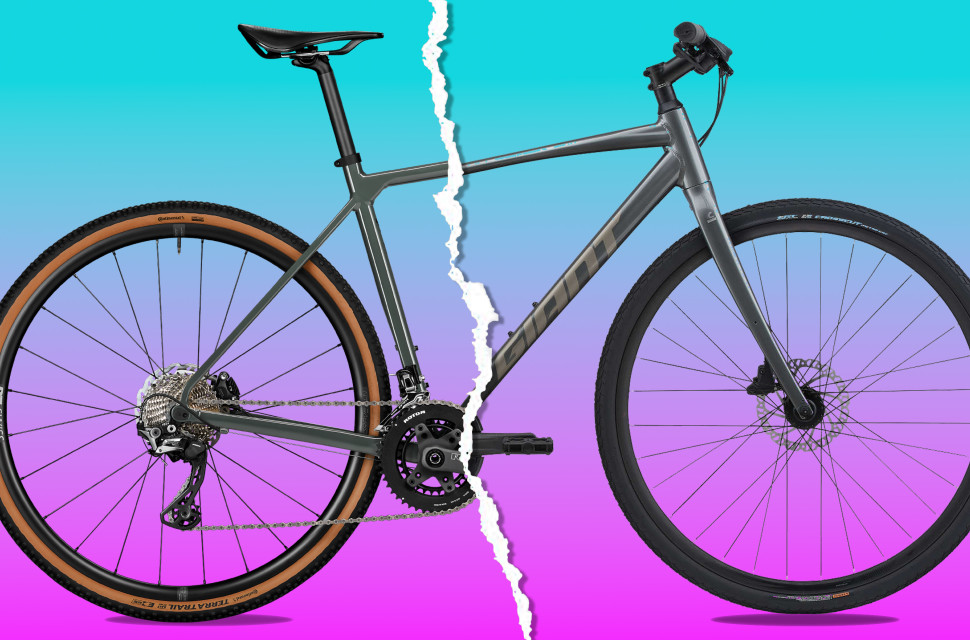Gravel bike vs hybrid bike - what are the differences?

Active commuting is a great way to keep fit and save on your transport budget while getting to work and back home. But the question for many riders is whether they require a dedicated active commuting bike?
- What is a gravel bike?
- Gravel bike vs mountain bike: what are the differences?
- Are gravel bikes good for commuting?
For many, the choice is to own a dual-purpose bike. Two of the most popular options for riders who want to park a dual-purpose commuter at their office desk or at that remote working venue is to choose a gravel or hybrid bike. But even between these two, there are distinct differences. Let’s take a closer look.
The case for hybrid bikes
If you want an affordable, dependable, easy-to-ride bike, the hybrid is exactly that. These bikes are designed to be rideable for all regardless of skill or fitness level. And that means very mild frame geometry and robust components, which require minimal maintenance.
Most hybrid bikes are constructed from aluminium because of this specific alloy's scale, recyclability and cost-benefit. In fact, several hybrids are budget aluminium hardtail mountain bike frames from many seasons ago, which have been repurposed as hybrids.
Very few hybrid bikes feature suspension of any kind because they aren’t intended to journey off-road, on terrain that would require an air or coil suspension fork up front.
Hybrid bike frame design often prioritises low standover height and pedalling comfort, with little consideration for performance riding issues like aerodynamics and steering agility. Step-through frames are common on hybrid bikes, and even on those hybrid frames with traditionally shaped triangles adjacent to each other, the geometry numbers are very mild.
To facilitate the comfiest riding position, hybrid bikes have flat handlebars, instead of drop handlebars. Touchpoints are usually oversized, with generously padded saddles and large-diameter grips.
Riding and stopping on a hybrid bike
Hybrid bike gearing is all about efficiency. Whether pedalling into a headwind or rolling up a long incline, more gears mean smaller steps in between, increasing the likelihood of finding that ideal ratio for any portion of your route.
The hybrid bike’s cassette and chainring combination creates the broadest spread of ratios, for the least intensity of effort, to keep you moving along most efficiently. Many hybrids still use 2x drivetrains, something that has all but disappeared from mountain bike specifications over the last few years.
On any bike the braking system is crucial, but considering the complexity of riding in traffic, with its implied collision risk, hybrid bike brakes are of even greater importance. Most hybrid bikes have transitioned to disc brakes, but not all hybrids use hydraulic assistance to boost braking power. That’s why you’ll see some hybrid bikes with oversized brake levers, to enhance the leverage effect on a non-hydraulic, cable-actuated disc brake system.
Hybrids are built to last, not to be light
If you are a dedicated active commuter riding significant weekly mileages, component wear and maintenance costs become a real consideration. And that’s where the cable-actuated brakes that many hybrid bikes are built with make sense – reducing the maintenance burden of having to regularly bleed hydraulic brakes.
It’s the same durability principle with other wear items such as cassettes and chainrings. You’ll never find ultralightweight rotational drivetrain components on a hybrid bike. Product planners spec these bikes with heavier cassettes and chainrings, which feature more material – making them last longer.
Hybrid bikes roll on tyres that prioritise durability (and thus, cost), not ride comfort or grip. Although tubeless tyres are now broadly standardised on most off-road bikes, for good reason, they’re not as prevalent with hybrids. And that means you’ll still have to endure the occasional avoidable puncture with a tube and handpump.
The case for gravel bikes
If hybrids are generalist bike designs, optimised for ease of riding and low maintenance, gravel bikes are quite the opposite.
Developed to offer riders speed and confidence across various terrain types, the gravel bike remains very on-trend. And why not? These bikes are much faster than mountain bikes on long off-road adventure rides, when you link gravel and fire roads, allowing riders to journey further and experience more in a given timeframe.
But how does the gravel bike factor as an active commuter? They make more sense than traditional road bikes, because gravel bikes roll larger volume tyres with larger tread blocks, providing a more cushioned ride quality and better braking and steering grip in wet conditions.
The fact that most gravel bike wheels and tyres are tubeless makes a huge difference regarding puncture-proofing. And truthfully, considering the available tubeless tyre technology, punctures on a commuter route should not be a thing anymore.
Fitness required
Gravel bikes don’t have the same gearing latitude as hybrids or road bikes. Most gravel bikes run 1x drivetrains, like mountain bikes, which means they run out of climbing or high-speed gearing before a 2x drivetrain road or hybrid bike would.
If fitness or fatigue are issues, the gravel bike isn’t for you. As an active commuter, the gravel bike is better suited to experienced riders with moderate to advanced fitness who can confidently turn a comparatively heavier climbing ratio up those inclines.
Gravel bike geometry
Gravel bike touchpoints differ from that on a hybrid bike, being a lot more performance orientated. Saddles are slimmer, which could be uncomfortable for some, especially if you aren’t commuting in bib-shorts or other cycling-specific padded pants.
The more demanding nature of a gravel bike’s geometry and its narrower gearing can make it a touch too challenging, for notice or unfit riders, as an active commuter. Beyond the cadence of fitness, riders who wish to use a gravel bike for commuting must also consider their flexibility.
Gravel bikes feature drop handlebars, allowing a more aerodynamic riding position. But if you have a legacy of back and shoulder issues and aren’t in great yoga health, cycling to work and home with drop handlebars could become a back strain issue. That’s where a hybrid's less aerodynamic riding position is better for riders who aren’t the most flexible.
For riders who lack confidence riding on the ‘drops in an aero position, it might become even more annoying if you have a laptop bag on your back, slinging around. That said, gravel bikes do have a lot of frame-carrying potential. Designed for adventure biking, gravel frames and forks feature many bosses and mounting points, where you can attach bags and pannier racks, similar to what is found on a hybrid.
Cost is a genuine difference between hybrid and gravel bikes. There’s no question of the latter being more versatile and a purer, more rewarding bike type to ride, but gravel bikes are more expensive than hybrids. With their hydraulic brakes, softer compound tyres and lighter components, expect that cost difference to widen even further when you compound the maintenance required over time.












